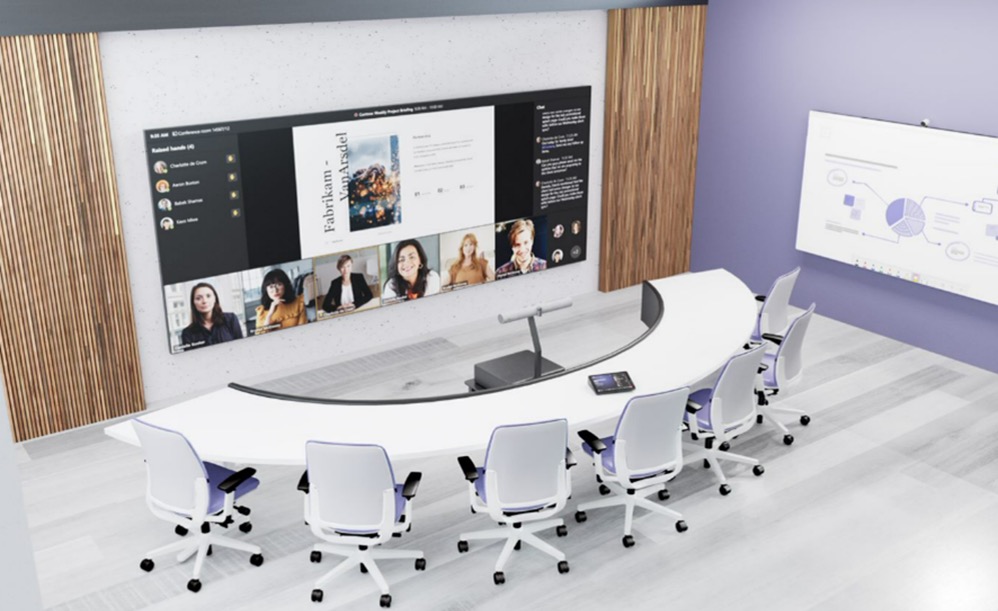The evolution of immersive video conferencing

Out with the old…
Traditional telepresence technology once provided the solution to remote high-quality meeting and event collaboration.
The average investment, however, was high, with significant network requirements, product investment, and specialist resources often resulting in costs exceeding £1million per room.
telepresence-tech.jpg
So, what made telepresence so expensive?

High-quality telepresence videoconferencing systems would have included three video conferencing codecs, each demanding high dedicated network bandwidth and incorporated three 65″ display screens, carefully chosen to represent life-like mid-shots of the participants with cameras strategically positioned in the middle of the screens to facilitate eye-to-eye contact.
Spatial sound technology would have been employed, enabling clear audio to emanate from the direction of the screens, making it seem as though the far-end participants were present in the room. A microphone would have been provided for all participants for optimal audio pickup. Acoustics were paramount with analysis to assess reverberation and sound transmission, ensuring an optimal in-room experience.
In addition, three-point broadcast lighting was often utilised, consisting of key, fill, and backlight sources, effectively illuminating in-room participants. For a seamless experience, the environments in all locations were meticulously designed to be identical, encompassing carpeting, wall covering, and furniture, creating a sense of sitting across the table from the far-end participants.
Video conferencing has evolved
In the hybrid working environments of today, the demand for videoconferencing technologies that can bridge the gap to how people collaborate and interact, eliminating the barriers of physical distance has been paramount. It is essential to consider how technology can enable employees to work effectively from anywhere and that all employees have access to the tools and resources necessary to perform their work, regardless of location.
Delivering Digital Equality in the Workplace
In today’s digital age, there are still significant disparities in digital access and skills among different groups of people. Bridging the digital divide and promoting digital equality is crucial for ensuring everyone has equal opportunities to fully participate in the digital age and benefit from its advantages.
Immersive video conferencing promotes digital equality by breaking barriers and providing equal access to high-quality virtual interactions. Extending beyond boardrooms to mobile devices, it empowers people in remote or underserved areas to connect and collaborate seamlessly to foster inclusivity and level the digital playing field for all.
This achievement, alongside our current migration competency, emphasises our goal of helping customers navigate their business challenges and run applications efficiently on the AWS Cloud.
Our team of accredited architects and engineers help businesses migrate their Microsoft workloads to AWS through a range of different services through designing, building, and managing highly scalable, secure, and dynamic environments.
In with the new
Companies like Microsoft and Logitech offer an immersive experience at a fraction of the cost. With the right acoustic treatments, all-in-one video conferencing systems, and advanced cameras providing that eye-to-eye experience, customers can achieve an immersive experience without breaking the bank.

To address this challenge, Logitech Sight comes to the rescue, providing a clear and responsive front-and-centre view that enhances the experience for remote attendees. With Logitech Sight, virtual participants can now see and hear in-room participants more clearly, making them feel like active participants at the table rather than passive observers on the periphery.

This evolution, accompanied by the promotion of digital equality, has made immersive video conferencing more inclusive and accessible. Traditional high-cost telepresence systems were once reserved for enterprise clients due to their substantial investment requirements. However, the landscape has shifted, with products like Logitech Sight bringing remote participants to the forefront, ensuring that all attendees can engage on an equal footing, regardless of their physical location. As we embrace these advancements, telepresence becomes an invaluable tool for businesses, enabling them to navigate the evolving landscape of hybrid work strategies easily and affordably.
Email the transACT Digital workplace team here to see how we can help on your digital collaboration journeys.